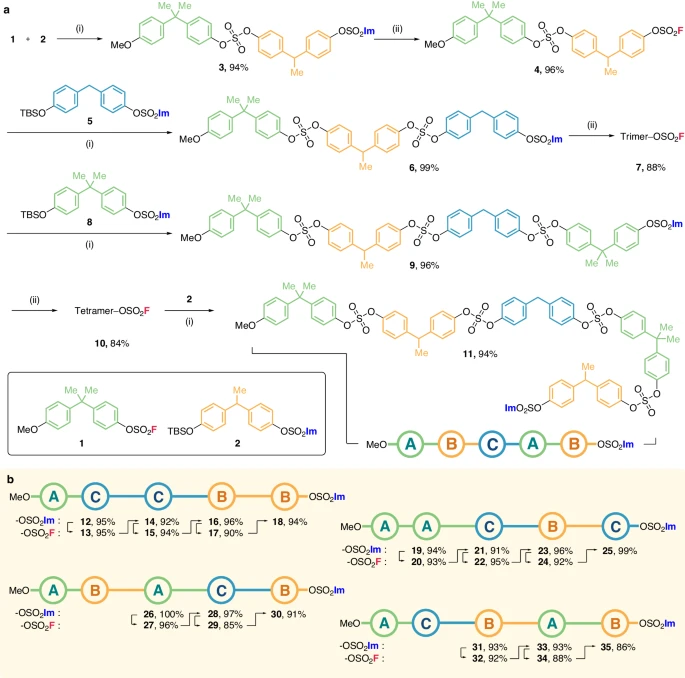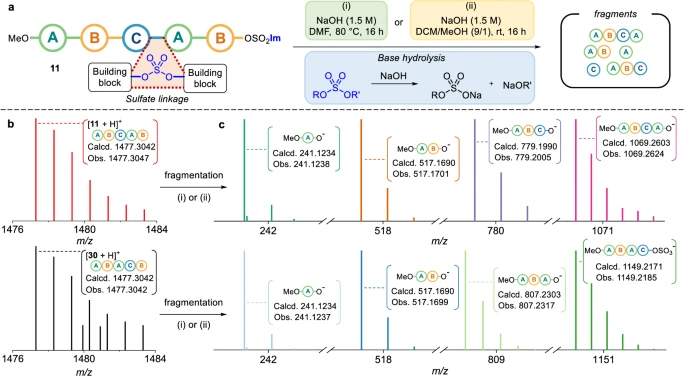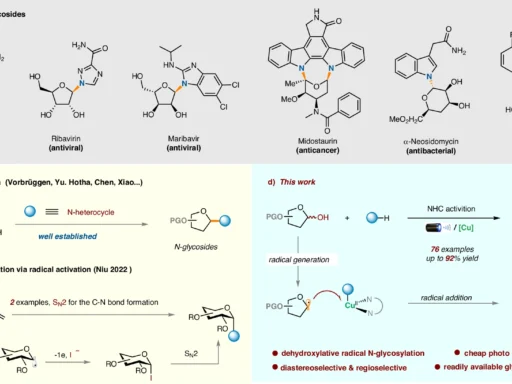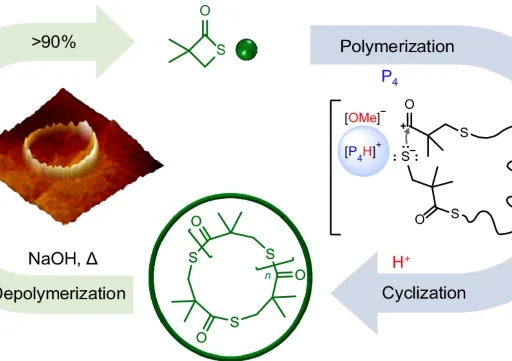Table of Contents
An iterative SuFEx approach is used to synthesize sequence-regulated oligosulfates, and its application is extended to periodic copolymers.
Sulfur fluoride exchange (SuFEx) chemistry has emerged as a powerful technique in chemical synthesis, providing meticulous manipulation and exceptional efficacy in producing diverse molecules. Nevertheless, traditional SuFEx techniques encounter constraints in synthesizing sequence-regulated oligosulfates and periodic copolymers. This article explores the revolutionary method of iterative SuFEx and its use in solving these difficulties.
An Overview of SuFEx Chemistry:
SuFEx, also known as sulfur (VI) fluoride exchange, is a recently discovered chemical reaction that has significantly transformed researchers’ approach toward chemical synthesis. The process entails the substitution of sulfur (VI) fluoride bonds, enabling the creation of intricate molecules with exceptional accuracy and effectiveness. Sulfur fluoride exchange (SuFEx) chemistry has attracted considerable interest because of its wide-ranging application and flexibility in generating a wide variety of molecular configurations. Overview of sequence-regulated iterative synthesis:

Drawbacks of Traditional SuFEx Techniques:
Although SuFEx chemistry has opened up new synthesis opportunities, conventional approaches face significant challenges in producing sequence-regulated oligosulfates and periodic copolymers. These issues arise from the complexity of managing the arrangement of functional groups along the polymer chain, which is essential for obtaining the desired characteristics. Traditional SuFEx techniques frequently lead to a haphazard arrangement of functional groups, which restricts the ability to manipulate molecule structure and characteristics.
Comprehending the concept of iterative SuFEx:
Iterative SuFEx is a significant advancement in the discipline, providing a solution to the constraints of traditional approaches. Scientists can accurately manipulate the arrangement of functional groups in oligosulfates and copolymers using an iterative method. This enables the creation of customized molecules with improved properties. The iterative SuFEx method involves adding functional groups slowly to the growing polymer chain. This lets the sequence and structure of molecules be carefully changed. Researchers can utilize this level of control to strategically create and combine molecules with precise characteristics tailored for diverse applications. Uni-directional iterative synthesis of sequence-regulated oligosulfates.

Application of Sequence-Regulated Oligosulfates:
Researchers have effectively synthesized sequence-regulated oligosulfates using the iterative SuFEx method, overcoming the difficulties encountered by conventional techniques. Researchers can customize the characteristics of the resultant molecules for specific purposes by manipulating the arrangement of functional groups along the oligosulfate chain. Because SuFEx is repeating, it’s easy to carefully change the structure of molecules. This makes it possible to make oligosulfates with specific sequences of functional groups. Precise control over molecular structure is essential in materials research, drug development, and biotechnology to achieve desired qualities, making this level of control highly valuable in these fields. Bi-directional iterative synthesis of sequence-regulated oligosulfates.

Expansion of Periodic Copolymers:
In addition to its use in oligosulfate synthesis, iterative SuFEx has expanded to include the production of periodic copolymers. Copolymers are often hard to make because it’s hard to control how the monomers are arranged along the polymer chain. This leads to a random distribution and unknown properties. Iterative SuFEx is a solution because it lets you change the exact order of the monomers, which makes it possible to make periodic copolymers with specific properties. The growth of SuFEx opens up new possibilities in polymer synthesis. It makes it easier to make copolymers with precise sequence and structure for a wide range of uses in biomedical engineering, coatings, and materials science.
The future outlook and areas for further study are worth exploring:
The emergence of iterative SuFEx signifies notable progress in chemical synthesis, exhibiting remarkable potential in several domains. As scientists continue to improve and perfect this method, we can expect to see more progress in creating intricate molecules with customized characteristics. In the future, researchers might look into applying iterative SuFEx to more types of chemicals, making the reaction conditions better, and seeing if it can be used for large-scale synthesis in commercial settings. Furthermore, there may be a focus on understanding the processes that drive SuFEx reactions and creating novel catalysts to improve reaction efficiency and selectivity. Oligosulfates sequencing by HRMS analysis.

In conclusion:
To sum up, the iterative SuFEx method looks like a promising way to solve the problems that come up when trying to make sequence-controlled oligosulfates and periodic copolymers. This novel technique allows for the exact manipulation of molecular sequences, thereby facilitating the synthesis of customized molecules with improved attributes. Through additional investigation and refinement, iterative SuFEx can fundamentally transform the domain of chemical synthesis and propel progress in diverse industries.
Distinct Frequently Asked Questions:
1). What are the differences between iterative and classic SuFEx methods?
Iterative SuFEx meticulously manipulates molecular sequence, enabling the synthesis of sequence-regulated oligosulfates and periodic copolymers, a difficult task to achieve using conventional techniques.
2). What are the possible uses of sequence-regulated oligosulfates?
Materials research, drug discovery, and biotechnology all use sequence-regulated oligosulfates because they require precise molecular structure manipulation.
3). What is how iterative SuFEx tackles the difficulties in copolymer synthesis?
Iterative SuFEx enables precise manipulation of monomer sequences, facilitating the production of periodic copolymers with customized characteristics. This approach overcomes the drawbacks of traditional random distribution approaches.
4). What are the primary advantages of using SuFEx chemistry in the synthesis process?
SuFEx chemistry provides researchers in diverse domains with a powerful tool for synthesizing complex compounds, offering great efficiency, precise control, and versatility.
5). What are some possible avenues for further study of iterative SuFEx?
A future study could concentrate on broadening the applicability of iterative SuFEx to more categories of chemicals, refining reaction conditions, and investigating its viability for large-scale synthesis in industrial settings. Furthermore, there may be a focus on understanding the processes that drive SuFEx reactions and creating novel catalysts to improve reaction efficiency and selectivity.
For more chemistry blogs, visit chemistry Master





